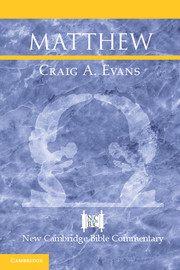III. - Commentary
Published online by Cambridge University Press: 05 June 2012
Summary
Matthew 1:1–17 – the Genealogy of the Messiah
1:1: An account of the genealogy of Jesus the Messiah, the son of David, the son of Abraham.
1:2: Abraham was the father of Isaac, and Isaac the father of Jacob, and Jacob the father of Judah and his brothers,
1:3: and Judah the father of Perez and Zerah by Tamar, and Perez the father of Hezron, and Hezron the father of Aram,
1:4: and Aram the father of Aminadab, and Aminadab the father of Nahshon, and Nahshon the father of Salmon,
1:5: and Salmon the father of Boaz by Rahab, and Boaz the father of Obed by Ruth, and Obed the father of Jesse,
1:6: and Jesse the father of King David. And David was the father of Solomon by the wife of Uriah,
1:7: and Solomon the father of Rehoboam, and Rehoboam the father of Abijah, and Abijah the father of Asaph,
1:8: and Asaph the father of Jehoshaphat, and Jehoshaphat the father of Joram, and Joram the father of Uzziah,
1:9: and Uzziah the father of Jotham, and Jotham the father of Ahaz, and Ahaz the father of Hezekiah,
1:10: and Hezekiah the father of Manasseh, and Manasseh the father of Amos, and Amos the father of Josiah,
1:11: and Josiah the father of Jechoniah and his brothers, at the time of the deportation to Babylon.
1:12: And after the deportation to Babylon: Jechoniah was the father of Salathiel, and Salathiel the father of Zerubbabel,
1:13: and Zerubbabel the father of Abiud, and Abiud the father of Eliakim, and Eliakim the father of Azor,
1:14: and Azor the father of Zadok, and Zadok the father of Achim, and Achim the father of Eliud,
1:15: and Eliud the father of Eleazar, and Eleazar the father of Matthan, and Matthan the father of Jacob,
1:16: and Jacob the father of Joseph the husband of Mary, of whom Jesus was born, who is called the Messiah.
1:17: So all the generations from Abraham to David are fourteen generations; and from David to the deportation to Babylon, fourteen generations; and from the deportation to Babylon to the Messiah, fourteen generations.
- Type
- Chapter
- Information
- Matthew , pp. 31 - 488Publisher: Cambridge University PressPrint publication year: 2012



